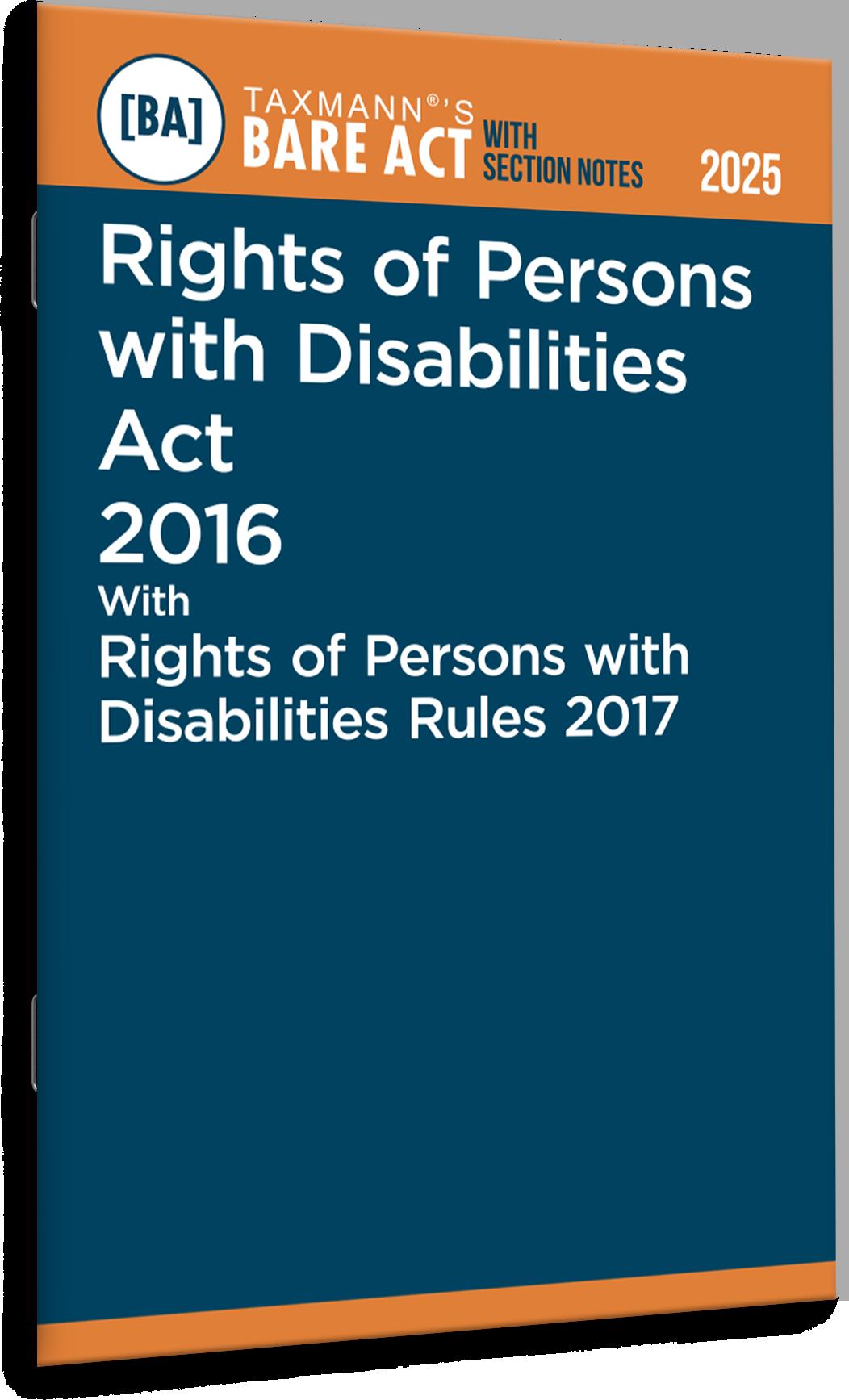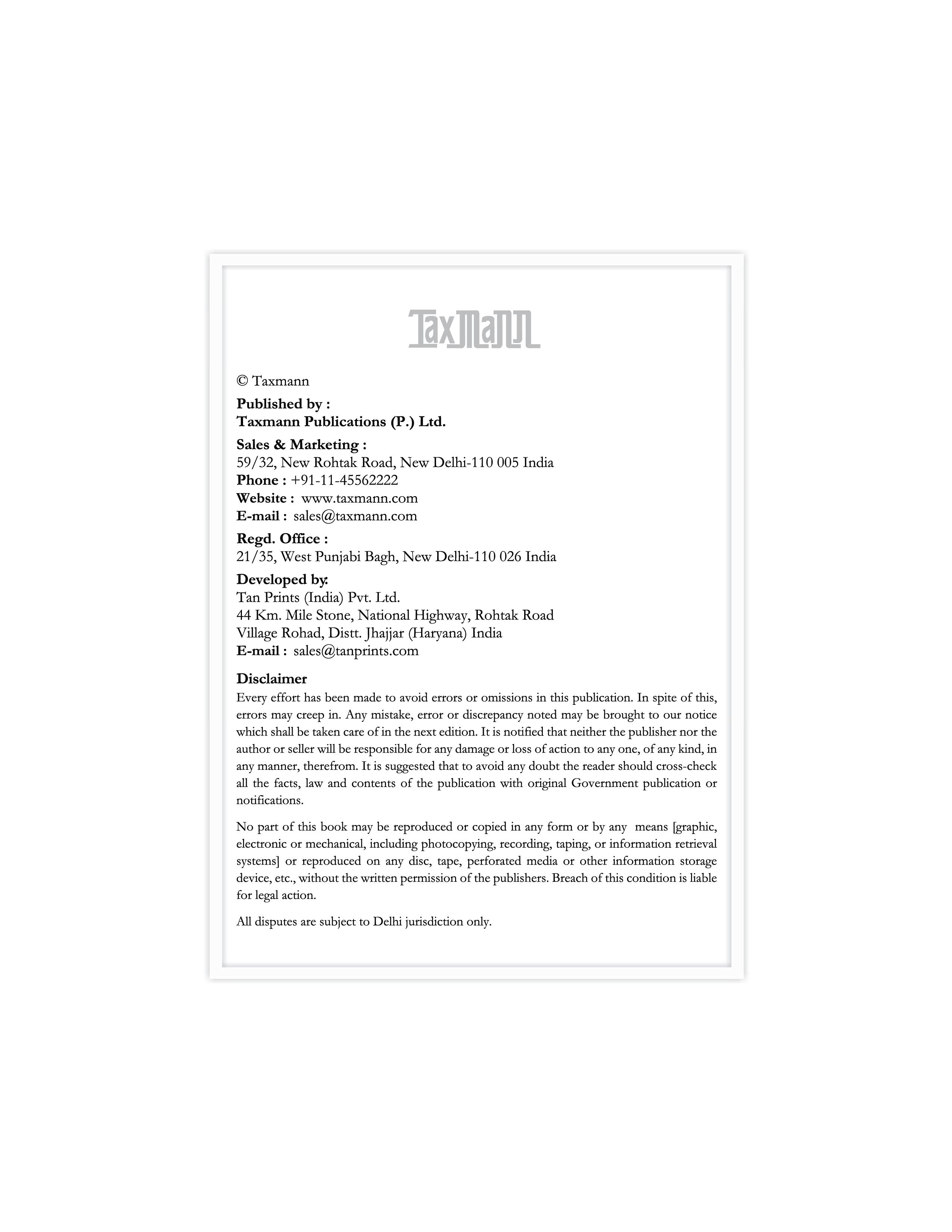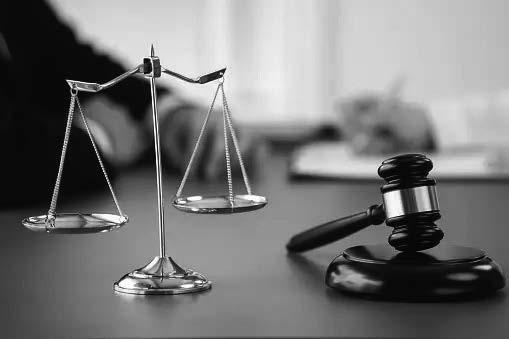RIGHTS OF PERSONS WITH DISABILITIES ACT, 2016
23.
CHAPTER V
CHAPTER VII
SPECIAL PROVISIONS FOR PERSONS WITH DISABILITIES WITH HIGH SUPPORT NEEDS
38. Special provisions for persons with disabilities with high support 30
CHAPTER VIII
DUTIES AND RESPONSIBILITIES OF APPROPRIATE GOVERNMENTS
39. Awareness campaigns 30
40. Accessibility
41. Access to transport
42. Access to information and communication technology
43. Consumer goods
44. Mandatory observance of accessibility norms
45. Time-limit for making existing infrastructure and premises accessible and action for that purpose
46. Time-limit for accessibility by service providers
CHAPTER IX
REGISTRATION OF INSTITUTIONS FOR PERSONS WITH DISABILITIES AND GRANTS TO SUCH INSTITUTIONS
49. Competent authority
50. Registration
51. Application and grant of certi cate of registration
52. Revocation of registration
53. Appeal
54. Act not to apply to institutions established or maintained by Central or State Government
55. Assistance to registered institutions
CHAPTER X
CERTIFICATION OF SPECIFIED DISABILITIES
56. Guidelines for assessment of speci ed disabilities
57. Designation of certifying authorities
CHAPTER XI
CHAPTER
84.
86. National fund for persons with disabilities
CHAPTER XV
88. State Fund for persons with disabilities
89. Punishment for contravention of provisions of Act or rules or regulations made thereunder
90. Offences by companies
91. Punishment for fraudulently availing any bene t meant for persons with benchmark disabilities
92. Punishment for offences of atrocities
102. Repeal and savings
SCHEDULE: Speci ed Disability
RIGHTS OF PERSONS WITH DISABILITIES RULES, 2017
CHAPTER I PRELIMINARY
1. Short title, extent and commencement 65
2. De nitions 65
CHAPTER II RIGHTS AND ENTITLEMENTS
3. Establishment not to discriminate on the ground of disability 66
4. Central Committee for Research on Disability 66
5. Person with disability not to be a subject of research 67
6. Procedure to be followed by Executive Magistrate 67
CHAPTER III
NODAL OFFICER IN THE DISTRICT EDUCATION OFFICE
7.
CHAPTER IV EMPLOYMENT
8. Manner of publication of equal opportunity policy 67
9. Form and manner of maintaining records by the establishments 68
10. Manner of maintenance of register of complaints by the Government establishments 68
CHAPTER V
VACANCIES FOR PERSONS WITH BENCHMARK DISABILITIES
11. Computation of vacancies 69
12. Interchange of vacancies
13. Submission of Returns on Vacancies
14. Form in which record to be kept by an employer 69 CHAPTER VA
15. Rules for Accessibility 71
16. Review of Accessibility Standards 74
CHAPTER VII CERTIFICATE OF DISABILITY
17. Application for disability certi cate and UDID Card 74
18. Issue of disability certi cate/UDID Card 75
19. Certi cate issued under rule 18 to be generally valid for all purposes 76
20. Validity of certi cate of disability issued under the repealed Act 76
CHAPTER VIII
CENTRAL ADVISORY BOARD ON DISABILITY
21. Allowances for the members of the Central Advisory Board 77
22. Notice of meeting 77
23. Presiding of cer 78
24. Quorum 78
25. Minutes 78
26. Business to be transacted at meeting 78
27. Agenda for the meeting of the Central Advisory Board 78
28. Decision by majority 78
29. No proceeding to be invalid due to vacancy or any defect 79
CHAPTER IX
CHIEF COMMISSIONER AND COMMISSIONER FOR PERSONS WITH DISABILITIES
30. Quali cation for appointment of Chief Commissioner 79
31. Quali cation for appointment of Commissioner 79
32. Method of appointment of the Chief Commissioner and Commissioner
33. Term of the Chief Commissioner and Commissioner
34. Salary and allowances of the Chief Commissioner and Commissioner 80
35. Other terms and conditions of service of the Chief Commissioner and Commissioner 81
36. Resignation and removal 81
37. Residuary provision
38. Procedure to be followed by Chief Commissioner and Commissioner 82
39. Advisory Committee to assist the Chief Commissioner
40. Submission of Annual Report
CHAPTER X
NATIONAL FUND FOR PERSONS WITH DISABILITIES
41.
42.
Rights of Persons with Disabilities Act, 2016
[49 OF 2016]*
An Act to give effect to the United Nations Convention on the Rights of Persons with Disabilities and for matters connected therewith or incidental thereto.
WHEREAS the United Nations General Assembly adopted its Convention on the Rights of Persons with Disabilities on the 13th day of December, 2006;
AND WHEREAS the aforesaid Convention lays down the following principles for empowerment of persons with disabilities,—
(a) respect for inherent dignity, individual autonomy including the freedom to make one’s own choices, and independence of persons;
(b) non-discrimination;
(
c) full and effective participation and inclusion in society;
(d) respect for difference and acceptance of persons with disabilities as part of human diversity and humanity;
(e) equality of opportunity;
(f) accessibility;
(
g) equality between men and women;
(h) respect for the evolving capacities of children with disabilities and respect for the right of children with disabilities to preserve their identities;
AND WHEREAS India is a signatory to the said Convention;
AND WHEREAS India ratified the said Convention on the 1st day of October, 2007; AND WHEREAS it is considered necessary to implement the Convention aforesaid.
BE it enacted by Parliament in the Sixty-seventh Year of the Republic of India as follows:—
* Dated 27-12-2016.
S. 2 RIGHTS OF PERSONS WITH DISABILITIES ACT, 2016 2
CHAPTER I PRELIMINARY
Short title and commencement.
1. (1) This Act may be called the Rights of Persons with Disabilities Act, 2016.
(2) It shall come into force on such date1 as the Central Government may, by notification in the Official Gazette, appoint.
Definitions.
2. In this Act, unless the context otherwise requires,—
(a) “appellate authority” means an authority notified under sub-section (3) of section 14 or sub-section (1) of section 53 or designated under sub-section (1) of section 59, as the case may be;
(b) “appropriate Government” means,—
(i) in relation to the Central Government or any establishment wholly or substantially financed by that Government, or a Cantonment Board constituted under the Cantonments Act, 2006 (41 of 2006), the Central Government;
(ii) in relation to a State Government or any establishment, wholly or substantially financed by that Government, or any local authority, other than a Cantonment Board, the State Government;
(c) “barrier’’ means any factor including communicational, cultural, economic, environmental, institutional, political, social, attitudinal or structural factors which hampers the full and effective participation of persons with disabilities in society;
(d) “care-giver” means any person including parents and other family Members who with or without payment provides care, support or assistance to a person with disability;
(
e) “certifying authority” means an authority designated under sub-section (1) of section 57;
(
f) “communication” includes means and formats of communication, languages, display of text, Braille, tactile communication, signs, large print, accessible multimedia, written, audio, video, visual displays, sign language, plain-language, human-reader, augmentative and alternative modes and accessible information and communication technology;
(g) “competent authority” means an authority appointed under section 49;
(h) “discrimination” in relation to disability, means any distinction, exclusion, restriction on the basis of disability which is the purpose or effect of
1. Notification No. SO 1215(E) [F.No.03-01/2017-DD-III], dated 19-4-2017.—In exercise of the powers conferred by sub-section (2) of section 1 of the Rights of Persons with Disabilities Act, 2016 (49 of 2016), the Central Government hereby appoints 19th day of April, 2017, as the date on which the said Act shall come into force.
3
impairing or nullifying the recognition, enjoyment or exercise on an equal basis with others of all human rights and fundamental freedoms in the political, economic, social, cultural, civil or any other field and includes all forms of discrimination and denial of reasonable accommodation;
(i) “establishment” includes a Government establishment and private establishment;
(j) “Fund” means the National Fund constituted under section 86;
(k) “Government establishment” means a corporation established by or under a Central Act or State Act or an authority or a body owned or controlled or aided by the Government or a local authority or a Government company as defined in section 2 of the Companies Act, 2013 (18 of 2023) and includes a Department of the Government;
(l) “high support” means an intensive support, physical, psychological and otherwise, which may be required by a person with benchmark disability for daily activities, to take independent and informed decision to access facilities and participating in all areas of life including education, employment, family and community life and treatment and therapy;
(m) “inclusive education” means a system of education wherein students with and without disability learn together and the system of teaching and learning is suitably adapted to meet the learning needs of different types of students with disabilities;
(
n) “information and communication technology” includes all services and innovations relating to information and communication, including telecom services, web based services, electronic and print services, digital and virtual services;
(o) “institution” means an institution for the reception, care, protection, education, training, rehabilitation and any other activities for persons with disabilities;
(
p) “local authority” means a Municipality or a Panchayat, as defined in clause (e) and clause (f) of article 243P of the Constitution; a Cantonment Board constituted under the Cantonments Act, 2006 (41 of 2006); and any other authority established under an Act of Parliament or a State Legislature to administer the civic affairs;
(q) “notification” means a notification published in the Official Gazette and the expression “notify” or “notified” shall be construed accordingly;
(r) “person with benchmark disability” means a person with not less than forty per cent of a specified disability where specified disability has not been defined in measurable terms and includes a person with disability where specified disability has been defined in measurable terms, as certified by the certifying authority;
(s) “person with disability” means a person with long term physical, mental, intellectual or sensory impairment which, in interaction with barriers, hinders his full and effective participation in society equally with others;
(t) “person with disability having high support needs” means a person with benchmark disability certified under clause (a) of sub-section (2) of section 58 who needs high support;
(u) “prescribed” means prescribed by rules made under this Act;
(v) “private establishment” means a company, firm, cooperative or other society, associations, trust, agency, institution, organisation, union, factory or such other establishment as the appropriate Government may, by notification, specify;
(w) “public building” means a Government or private building, used or accessed by the public at large, including a building used for educational or vocational purposes, workplace, commercial activities, public utilities, religious, cultural, leisure or recreational activities, medical or health services, law enforcement agencies, reformatories or judicial foras, railway stations or platforms, roadways bus stands or terminus, airports or waterways;
(x) “public facilities and services” includes all forms of delivery of services to the public at large, including housing, educational and vocational trainings, employment and career advancement, shopping or marketing, religious, cultural, leisure or recreational, medical, health and rehabilitation, banking, finance and insurance, communication, postal and information, access to justice, public utilities, transportation;
(y) “reasonable accommodation” means necessary and appropriate modification and adjustments, without imposing a disproportionate or undue burden in a particular case, to ensure to persons with disabilities the enjoyment or exercise of rights equally with others;
(z) “registered organisation” means an association of persons with disabilities or a disabled person organisation, association of parents of persons with disabilities, association of persons with disabilities and family members, or a voluntary or non-governmental or charitable organisation or trust, society, or non-profit company working for the welfare of the persons with disabilities, duly registered under an Act of Parliament or a State Legislature;
(za) “rehabilitation” refers to a process aimed at enabling persons with disabilities to attain and maintain optimal, physical, sensory, intellectual, psychological environmental or social function levels;
(zb) “Special Employment Exchange” means any office or place established and maintained by the Government for the collection and furnishing of information, either by keeping of registers or otherwise, regarding—
(i) persons who seek to engage employees from amongst the persons with disabilities;
(ii) persons with benchmark disability who seek employment;
(iii) vacancies to which persons with benchmark disabilities seeking employment may be appointed;
5 RIGHTS OF PERSONS WITH DISABILITIES ACT, 2016 S. 2
(zc) “specified disability” means the disabilities as specified in the Schedule; (zd) “transportation systems” includes road transport, rail transport, air transport, water transport, para transit systems for the last mile connectivity, road and street infrastructure, etc.;
(ze) “universal design” means the design of products, environments, programmes and services to be usable by all people to the greatest extent possible, without the need for adaptation or specialised design and shall apply to assistive devices including advanced technologies for particular group of persons with disabilities.
COMMENTS
SECTION NOTES
2.1 “Person with disability” [Section 2(s)]
The term “person with disability” means a person satisfying the following criteria; He/she is a person with long-term physical, mental, intellectual or sensory impairment and;
Such impairment, in interaction with barriers, hinders his/her full and effective participation in society equally with others;
The impugned act or omission will not be treated as discrimination if it shown to be a proportionate means of achieving a legitimate aim; [See Section 3(2)]
See Section 2(c) for the definition of “barriers”.
See Section 2(r) for the definition of “person with benchmark disability”.
Chapter II of this Act, comprising sections 3 to 15, provide for the following rights and entitlements of person with disability:
Equality and non-discrimination.(Section 3)
Women and children with disabilities.(Section 4)
Community life.(Section 5)
Protection from cruelty and inhuman treatment. (Section 6 )
Protection from abuse, violence and exploitation. (Section 7)
Protection and safety. (Section 8)
Home and family. (Section 9)
Reproductive rights.(Section 10)
Accessibility in voting. (Section 11)
Access to justice. (Section 12)
Legal capacity.(Section 13)
Provision for guardianship.(Section 14)
Designation of authorities to support.(Section 15)
Section 16 of the Act provides that the appropriate Government and the local authorities shall endeavour that all educational institutions funded or recognised by them provide inclusive education to the children with disabilities . Section 17 provides that the appropriate Government and the local authorities shall take specific measures for the purpose of section 16.





